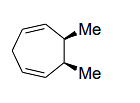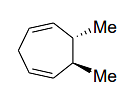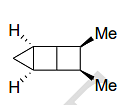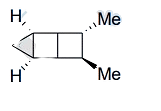The major product formed in the following reaction

is.

is.
The Correct Option is A
Solution and Explanation
The reaction involves the treatment of an alkene with an acidic catalyst and heat. This reaction typically leads to a cyclohexene derivative, as seen in option (A). The reaction proceeds through a mechanism that involves the formation of a cyclic product with the methyl groups on the same carbon.
The correct option is (A) : 
Top Questions on Reaction Mechanisms & Synthesis
- The reaction \( \text{A}_2 + \text{B}_2 \to 2\text{AB} \) follows the mechanism: \[ \text{A}_2 \xrightarrow{k_1} \text{A} + \text{A} \, (\text{fast}), \quad \text{A} + \text{B}_2 \xrightarrow{k_2} \text{AB} + \text{B} \, (\text{slow}), \quad \text{A} + \text{B} \to \text{AB} \, (\text{fast}). \] The overall order of the reaction is:
- JEE Main - 2025
- Chemistry
- Reaction Mechanisms & Synthesis
- In the Claisen-Schmidt reaction to prepare dibenzalacetone from 5.3 g benzaldehyde, a total of 3.51 g of product was obtained. The percentage yield in this reaction was _____.
- JEE Main - 2025
- Chemistry
- Reaction Mechanisms & Synthesis
- The reaction represented by A → B follows first order kinetics. At a given temperature, 20\% of the reaction is completed in 223 s. The time taken to complete 50\% of the reaction at the same temperature is ............ s (rounded off to the nearest integer).
- GATE MT - 2025
- Mineral Processing and Extractive Metallurgy
- Reaction Mechanisms & Synthesis
- Molten steel at 1900 K having dissolved hydrogen needs to be vacuum degassed. The equilibrium partial pressure of hydrogen to be maintained to achieve 1 ppm of dissolved hydrogen is .............. Torr (rounded off to two decimal places).
- GATE MT - 2025
- Mineral Processing and Extractive Metallurgy
- Reaction Mechanisms & Synthesis
- Match the steel plant related processes in Column I with the associated information in Column II. Column I: P. Corex
Q. Electric Arc Furnace
R. Midrex
S. Continuous Casting
Column II: 1. Melter-gasifier
2. Natural gas reformer
3. Electromagnetic stirrer
4. Hot heel
- GATE MT - 2025
- Mineral Processing and Extractive Metallurgy
- Reaction Mechanisms & Synthesis
Questions Asked in IIT JAM CY exam
One mole of a monoatomic ideal gas starting from state A, goes through B and C to state D, as shown in the figure. Total change in entropy (in J K\(^{-1}\)) during this process is ...............

- IIT JAM CY - 2025
- Thermodynamics
The number of chiral carbon centers in the following molecule is ...............

- IIT JAM CY - 2025
- General Chemistry
- Consider the following matrices A and B.
\[ A = \begin{pmatrix} 1 & 2 & 0 & 0 \\ 3 & 4 & 0 & 0 \\ 0 & 5 & 5 & 0 \\ 0 & 0 & 6 & 7 \\ 0 & 0 & 8 & 9 \end{pmatrix} \quad \text{and} \quad B = \begin{pmatrix} 10 & 11 & 0 & 0 & 0 \\ 12 & 13 & 0 & 0 & 0 \\ 0 & 0 & 4 & 0 & 0 \\ 0 & 0 & 15 & 16 & 0 \\ 0 & 0 & 17 & 18 & 0 \end{pmatrix} \]
If \( C = AB \), the sum of the diagonal elements of \( C \) is ..............
- IIT JAM CY - 2025
- General Chemistry
A tube fitted with a semipermeable membrane is dipped into 0.001 M NaCl solution at 300 K as shown in the figure. Assume density of the solvent and solution are the same. At equilibrium, the height of the liquid column \( h \) (in cm) is .........

- IIT JAM CY - 2025
- General Chemistry
An electron at rest is accelerated through 10 kV potential. The de Broglie wavelength (in A) of the electron is .............
- IIT JAM CY - 2025
- General Chemistry


